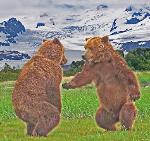Diving Bear Cove, at the mouth of Wolverine Creek, is one of Alaska's most
popular viewing sites. it lies between two active volcanoes -- Mt. Spur to the
north near Anchorage, and Mt. Redoubt to the south (image at upper
right). Just west of Wolverine Lake is Mt. Mastadon, a long-dead volcano.
Some of the lakes of the Big River Lakes system may be ancient calderas,
as evidenced by the andesite bedrock surrounding them.
popular viewing sites. it lies between two active volcanoes -- Mt. Spur to the
north near Anchorage, and Mt. Redoubt to the south (image at upper
right). Just west of Wolverine Lake is Mt. Mastadon, a long-dead volcano.
Some of the lakes of the Big River Lakes system may be ancient calderas,
as evidenced by the andesite bedrock surrounding them.



Volcanoes
Hawaiian volcanoes, such as that at left, spew out fountains of liquid rock, lava,
that flow downhill in rivers. Such liquid lava comes from magma low in silica but
high in dissolved water. By contrast, Alaska's silica-rich andesite magma
doesn't flow out as lava. This magma is so thick (viscous) that it traps the
pressure from overlying rock suddenly declines as that rock cracks. Then the
water explodes into superheated steam, expanding in volume up to 1000-fold.
Magma explodes into rock dust as finely grained as the ash left in a fireplace
after wood is burned. Hence the term volcanic ash. The same thing happened
with Mt. St. Helens. An ash eruption begins with a fountain of incandescent
particles, as shown below, then explodes upwards as shown in the next five
photos, releasing more energy than an atomic blast, yet producing similar cloud
formations. Friction among ash particles produces lightening, as shown below.
that flow downhill in rivers. Such liquid lava comes from magma low in silica but
high in dissolved water. By contrast, Alaska's silica-rich andesite magma
doesn't flow out as lava. This magma is so thick (viscous) that it traps the
pressure from overlying rock suddenly declines as that rock cracks. Then the
water explodes into superheated steam, expanding in volume up to 1000-fold.
Magma explodes into rock dust as finely grained as the ash left in a fireplace
after wood is burned. Hence the term volcanic ash. The same thing happened
with Mt. St. Helens. An ash eruption begins with a fountain of incandescent
particles, as shown below, then explodes upwards as shown in the next five
photos, releasing more energy than an atomic blast, yet producing similar cloud
formations. Friction among ash particles produces lightening, as shown below.




To protect their
lungs, people
wore dust masks.
The ground is
not covered with
snow, but with
ash in the photo
at right.
lungs, people
wore dust masks.
The ground is
not covered with
snow, but with
ash in the photo
at right.



| Bear Viewing Association To watch, to wonder, and to conserve [email protected] Ph/Fax (907) 260-9059 (Office) 39200 Alma Ave. Soldotna, AK 99669 |


| Bear Viewing Association To watch, to wonder, and to conserve [email protected] Ph/Fax (907) 260-9059 (Office) 39200 Alma Ave. Soldotna, AK 99669 |


Vulcanism 2